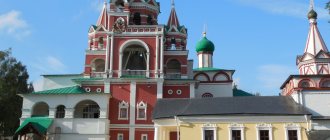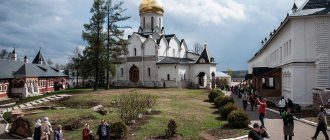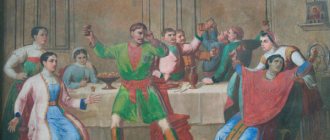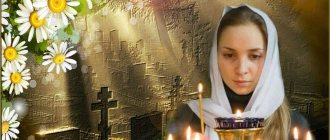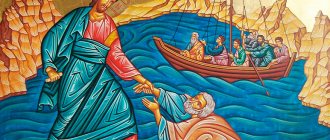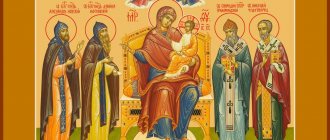December 16 (December 3, Old Art.) The Church honors the memory of the Monk Savva of Storozhevsky, the Zvenigorod wonderworker, one of the closest disciples and associates of the Venerable. Sergius of Radonezh. The Monk Savva became the founder and first abbot of the Mother of God of the Nativity (Savvino-Storozhevsky) Monastery in Zvenigorod, which was the first in the history of Rus' to receive the status of a Lavra. Here, during the abbotship of St. Savva, the famous icon painter Andrei Rublev worked and created a unique Zvenigorod rite, part of which was found in 1918-1919 in Gorodok, including the famous “Spas Zvenigorodsky” (“Russian Spas”; now kept in the Tretyakov Gallery). The first life of the Monk Savva Storozhevsky was written in the 16th century by the hagiographer and expert in hook singing Markell Khutynsky (nicknamed the Beardless). It is noteworthy that the short life of the saint was translated into modern literary language by the great Russian poet A. S. Pushkin.
Life of St. Savva of Storozhevsky
No information has been preserved about the childhood and adolescence of the Monk Savva, before his arrival at the monastery. The year and place of his birth are also unknown. The life story begins from the time when the young ascetic came to the monastery of St. Sergius of Radonezh and received monastic vows from him. Under the guidance of the great abbot, the monk Savva practiced fasting and contemplation of God, being in constant struggle, humility and labor. For his piety and inner success, he was awarded the priesthood and was elected confessor of the monastery.
After the victory on the Kulikovo field, the noble prince Dimitri Ioannovich Donskoy, in accordance with his vow, decided to create a community monastery in the name of the Most Holy Theotokos. He turned to the Monk Sergius for help, and the monk chose a secluded place on the Dubenka River, where he built a church, and then created a monastery in honor of the Dormition of the Mother of God. The Monk Savva was appointed rector, as a very experienced and skillful monk, capable of paternal care for the brethren (according to other sources, the question of the abbot of Savva of Storozhevsky in the Holy Dormition Dubensky Monastery is very controversial, since the abbot at that time was another Savva - Stromynsky ).
The Monk Savva was respected not only among the monastery brethren and ordinary laymen, but also among the princely family. He was the spiritual father of the widow of Prince Dmitry Donskoy Evdokia (in monasticism Euphrosyne) and their third son (second by right of inheritance) Yuri of Zvenigorod. In 1395 (according to other sources - in 1399) Yuri Zvenigorodsky turned to the Monk Savva for a blessing to go to Volga Bulgaria. The monk blessed the prince for his feat of arms and predicted a glorious victory for him. The battle ended in the complete defeat of the enemy: Yuri Zvenigorodsky managed to take 14 cities, including the Great Bulgar, Dzhuke-Tau and Kazan, and from then on he began to venerate the holy elder even more.
After the death of St. Sergius, St. Savva, heeding the prayers of the brethren, ruled the Trinity monastery for about six years, since Nikon of Radonezh, who was blessed to be the abbot, went into seclusion for that time. Then, like his God-bearing mentor, he brought out a spring outside the northern wall of the monastery, since the brethren suffered from a lack of water. But in 1398, the pious Prince Yuri of Zvenigorod established the good intention of creating a monastic monastery in his vicinity and invited the Monk Savva for this purpose. The place was chosen on Mount Storozhevskaya, one and a half miles from Zvenigorod itself. Placing all his hope in the Most Holy Theotokos, the holy ascetic settled in a new place, where he soon erected a wooden church in honor of the Nativity of the Most Pure Mother of God and built himself a small cell. Gradually, the brethren began to gather around him, and the godly elder with fatherly love received everyone and guided them on the path of salvation. Thus, a new communal monastery was soon established. The Zvenigorod prince took care of the monastery in every possible way and made large contributions. Shortly before the repose of the saint, he erected a majestic stone church in honor of the Nativity of the Virgin Mary (instead of the previous wooden one), which has survived to this day.
Library of the Russian Faith Life of St. Sava of Storozhevsky. Great Menaion of Cheti →
Read online in original
Feeling approaching eternity, the Monk Savva began to strive for greater solitude and for this purpose he dug himself a small cave about a mile from the monastery. The saint of God reposed at a ripe old age on December 3, 1407, giving everyone peace and a last kiss. He appointed one of his students, also named Savva, as his successor. The news of his blessed death quickly spread throughout the Zvenigorod outskirts: many people gathered for the funeral, everyone said goodbye to the monk, as if to his own father. The body of the Monk Sava was buried on the right side at the Church of the Nativity of the Mother of God.
Skete of Saint Sava
Located near the monastery. Previously, it was a small cave dug into the mountainside. The holy elder retired there to perform prayers.
The monastery was founded through the efforts of the Moscow Metropolitan, St. Philaret and manufacturer P.G. Tsurikova. At that place at the end of the 19th century. a church and cells were erected. During the revolution, soldiers were stationed on its territory.
Nowadays, restoration work is being carried out to restore it.
Veneration and glorification of St. Savva of Storozhevsky
Local veneration of the Monk Savva of Zvenigorod began immediately after his repose. The first icon of the saint was painted at the beginning of the 16th century by the abbot of the Savvino-Storozhevsky Monastery, Dionysius. In a charter of 1539, the Monk Savva is called a miracle worker. In the middle of the 16th century. a description of the miracles was compiled. The church-wide glorification of the saint took place in 1547, on the initiative of the monastery brethren and Metropolitan Macarius of Moscow, and on January 19 (29), 1652, after 245 years of sojourn in damp soil, the incorruptible relics of the saint were found. The oak tomb with the relics was placed in the Nativity of the Virgin Cathedral at the southern gate of the altar.
Troparion, kontakion and canon to St. Savva of Storozhevsky
Troparion, tone 8:
You appeared in the desert to provide good vegetation, reverend, from your youth you willed a pure life. Having followed the spiritual teacher, he fixed his mind on the heavenly teachings, and the teacher showed himself to his flock to be wise. In this way Christ also brightened thee lamp with miracles. Savo, from our souls, pray for our souls to be saved.
Kontakion, voice 2:
Inflamed by the Lord's desire, the passions of the flesh were shaken off by abstinence, and the divine light, the unstoppable luminary, appeared. You illuminate miracles with the rays of all that flow to the race of your relics, O Reverend Father Savo.
Library of the Russian Faith Canon to St. Sava of Storozhevsky →
Read online
Prayer
O most honorable and sacred head! Citizen of heavenly Jerusalem, abode of the Most Holy Trinity, Reverend Father Savvo! Having great boldness towards the All-Merciful Master, pray for the flock of your fence and for all your children in spirit. Do not remain silent when you cry to the Lord for us and do not despise those who honor you with faith and love. By your intercession, ask the King of those who reign for the peace of the Church, under the sign of the militant cross, for the bishop's splendor, for the good monastics in their labors; protection of this holy monastery, this city and all cities and countries; serenity and peace to the world, deliverance from famine and destruction; comfort and reinforcement for the old and weak, good growth in faith for the young and infants, solid training in the Gospel teaching, and abiding in purity and chastity; mercy and intercession to widows and orphans, joy and return to the captives, healing to those who are sick, peace to the faint-hearted, correction to those who have gone astray, those who sin with a spirit of contrition, those in need, and to all who require grace-filled help, timely help. Do not disgrace us, who come to you with faith, make haste, like a loving father to your children, for us to bear the yoke of Christ in complacency and patience, and guide us all in peace and repentance, to end our lives shamelessly and settle down with hope in the heavenly abode. Where you, through your labors and struggles, are now living with the Angels and Saints, in vain and glorifying God, glorified in the Trinity, the Father and the Son and the Holy Spirit. Amen.
The Lord is always with you!
Miracles of St. Savva of Storozhevsky
Numerous healings were accomplished through the prayers of the Monk Sava; more than once, even after his departure to another world, he provided miraculous help to the inhabitants of his monastery when they were in danger or suffered some kind of need. His first icon was miraculously painted.
Once, many years after his repose, the Monk Savva appeared in a dream to Abbot Dionysius, who was a skilled icon painter, identified himself by name and ordered him to paint his image. Then Dionysius called to him the ancient elder Avvakum, who, having come to the monastery at a young age, saw the monk still alive, and began to question him in detail about his appearance. Convinced that the vision was true, Dionysius painted an icon of the saint in the image that he saw in the dream. After some time, this same abbot Dionysius fell into strong temptation due to the slander of careless monks, who made a slanderous denunciation against him to the Grand Duke John Vasilyevich. The prince at first believed the slander, and the abbot began to grieve greatly over this. But the Monk Savva again appeared to him in a dream and ordered him not to grieve about anything, but to rely on the will of God. And thus, through the prayers of the monk, the slanderers were put to shame, and the abbot, after an explanation with the Grand Duke, returned to his monastery with great honor.
The discovery of the relics of the saint of God, St. Savva, was also preceded by one miraculous circumstance. Once getting separated from his retinue while hunting in the Zvenigorod forests, Tsar Alexei Mikhailovich almost died during a solo encounter with a bear. But then a handsome old man appeared and drove the beast away. Asked about his name, he called himself Savva and a monk of the Storozhevsky monastery and quickly disappeared into the forest. The grateful king hurried to the monastery to find this monk, but there was not a single elder named Savva there. Then the king, looking carefully at the image of the Monk Savva of Storozhevsky, realized that the saint himself had appeared to him. He ordered a prayer service to be served and the coffin to be examined for the preparation of St. relics of St. Savva for the grand opening.
In 1812, when Napoleon approached Moscow, a detachment of the Viceroy of the Italian Prince Eugene (Eugene) Beauharnais was stationed in the Savvino-Storozhevsky Monastery. The soldiers immediately began looting, not sparing church property. But, as Prince Eugene himself later said, soon, either in a dream or in reality, a formidable old man in a black monastic vestment appeared before him. He ordered him not to plunder the monastery, promising for this a successful outcome to his homeland. When the frightened Eugene recognized the elder who had appeared to him from the image on the icon, he ordered the church to be sealed and sent his army to Moscow. Subsequently, the descendants of Beauharnais became related to the Russian imperial house - the son of Prince Eugene married the daughter of Emperor Nicholas I. This family lived in Russia until 1917 under the name of the Dukes of Leuchtenberg.
Construction of the Zvenigorod Monastery
Construction of the monastery began in 1396 and was completed closer to 1405. Several churches were erected on the territory of the new monastery, the painting of which was entrusted to the then unknown Andrei Rublev. With the blessing of Savva Storozhevsky himself, Rublev wrote “The Savior of Zvenigorod”, and also became the author of the Zvenigorod rite.
Savva’s influence on the young artist was so great and beneficial that, according to some historians, it was Savva Strozhevsky who inspired Rublev to write his famous “Trinity”. Savva saw considerable talent in the young lad, so shortly before his death he entrusted his fate into the hands of his spiritual son Yuri.
Thanks to the efforts of Savva Storozhevsky, his inexhaustible energy and piety, the Zvenigorod monastery turned into a kind of Kitizh-grad, where every Orthodox Christian, who had some kind of sin or concern on his heart, sought to go.
Savva Storozhevsky received everyone who came to him with their sorrows, listened and gave advice, acting as his great teacher Sergius of Radonezh once did. All his life the monk did not turn away from anyone, remembering that the ways of the Lord are inscrutable, and it is not given to man to judge God’s plan, but only to guide and humbly pray for the fate of sinners.
During his long life, the elder blessed many couples with holy marriage vows, among whom were also Prince Yuri and his bride Anastasia, who lived a happy and long life. And this despite the fact that the marriage was purely political, since it allowed Prince Yuri to lay claim to most of the Russian lands. Most likely, if the idea of Yuri and, to some extent, Savva himself had succeeded, the Russian lands would have been united into one state much earlier than planned, but this did not happen.
After the death of Savva in December 1407, the Zvenigord monastery fell into decay, which was associated with the desire of the descendants of Yuri’s brother Vasily, who took the throne, to erase the very memory of the existence of the monk, who was the mentor of the hated relative.
Rev. Savva Storozhevsky. Icons
The Monk Savva is depicted in traditional monastic attire. A black mantle (pali) is thrown over the cassock - a long, sleeveless cape with a clasp at the collar. The black color of the mantle is a symbol of peace, complete detachment from the bustling outside world, as well as renunciation of one’s own passions. The saint's right hand is raised in a blessing gesture, and in his left hand there is a rolled scroll - a symbol of the Gospel of God. In other iconographic versions, in the left hand of the saint there may be an unrolled scroll or an icon of the Mother of God with the Infant Christ.
St. Savva (fragment). Icon. Moscow. Middle of the 17th century Deesis Row of the Storozhevsky Monastery Cathedral
Venerable Savva of Storozhevsky, with a life in 12 hallmarks. 1835 State Russian Museum, St. Petersburg
St. Savva Storozhevsky. Icon. Moscow. XVII century From the Church of the Resurrection of the Word on the Assumption Vrazhek in Moscow. Zvenigorod Monastery
Saints Reverend Sergius of Radonezh and Savva of Zvenigorod. 2nd half XIX century. Mstera, Old Believer school (Alexey Suslov)
Reverend Savva of Zvenigorod of Storozhevsky. First half of the 18th century. Moscow region
St. Savva. Sewn veil. Photo from the beginning of the 20th century. Moscow. XVII century
Rev. Savva Storozhevsky. Modern icon
In August 2007, a monument to St. St. was unveiled at the entrance to the Savvino-Storozhevsky Monastery. Save Storozhevsky (sculptor Sergei Sorokin).
Foundation of a new monastery
Here Abbot Savva remained for some time, serving the brethren with all zeal. Being the spiritual child of the Monk Savva, he was visited by the son of Demetrius Donskoy, the blessed Prince George. He begged the monk to visit his house in Dmitrov. Wanting to have a spiritual father nearby, George begged the monk to found a monastery in his homeland - the place of Storozhi near the town of Zvenigorod.
Savva obeyed the prince, took with him the Smolensk Icon of the Mother of God, and in a chosen place, strengthened by prayer to the Mother of God and the Savior of our souls, he erected a church, which he consecrated in honor of the Nativity of the Most Holy Theotokos.
The monk built a cell for himself, to which Orthodox people gradually began to flock, and this became the beginning of a communal monastery. The prince supported the saint in every possible way, showing him endless trust. The noble prince ordered the construction of a stone church, and gave the monk the money and villages necessary to build the monastery.
Prince Yuri Dmitrievich undertook a very successful military campaign on the territory of the Horde, against the Volga Bulgars, having previously secured the prayerful support of Saint Sava and asked for his blessing. The campaign ended with the capture of 14 enemy cities and the complete victory of the Russian troops, which saved Rus' from the invasion of Tamerlane and the complete destruction of the state.
After the campaign, construction of the Assumption Church on Gorodok began. To paint the stone church in Storozhi and the Assumption Church, the saint invited young Andrei Rublev and blessed him to paint the Zvenigorod rite - three icons depicting the Savior, Archangel Michael and Apostle Paul.
Savvino-Storozhevsky Monastery
The currently operating Savvino-Storozhevsky Monastery (ROC) is located on Mount Storozhi at the confluence of the Storozhka River with the Moscow River, 2 km west of the city of Zvenigorod, Moscow Region.
In honor of the Venerable Savva of Storozhevsky, the chapel of the Cathedral of the Nativity of the Blessed Virgin Mary of the Savvino-Storozhevsky Monastery, built at the beginning of the 15th century, was consecrated.
Cathedral of the Nativity of the Blessed Virgin Mary of the Savvino-Storozhevsky Monastery with a chapel in honor of St. Savva Storozhevsky
In the 15th-17th centuries, the monastery played an important strategic role in the defense of the western side of the capital, and also became a favorite place of prayer for many Russian tsars. Ivan IV the Terrible with his wife Anastasia Romanovna and their son Fyodor Ioannovich visited here. Under Tsar Alexei Mikhailovich, the monastery turned into a country royal residence. At this time, the empress's palace, royal chambers and external stone walls were erected in the monastery. The temples of the monastery were painted by the most famous icon painters of the Armory Chamber of the Moscow Kremlin.
The Zvenigorodsky tract was laid from Moscow to the Savvino-Storozhevsky Monastery, which was also known as the Tsar’s Road or the Road of God’s Chosen Kings; all Russian rulers: grand dukes, tsars and emperors made obligatory pilgrimages to the monastery to the relics of Savva Storozhevsky more than once. In the first half of the 20th century, this road was called Zvenigorodskoe Highway, but now it is better known as Rublevo-Uspenskoe Highway.
Savvino-Storozhevsky Monastery
Soon after the revolution, the monastery was closed and destroyed. On March 17, 1919, the relics of St. Savva were uncovered. The result of the opening of the relics was published in the report of the VIII department of the People's Commissariat of Justice of the RSFSR to the Congress of Soviets, in which it was described as follows: “a doll made of cotton wool; there are 33 badly destroyed and broken bones in the wool.” On April 5, 1919, the relics of St. Savva were removed from the monastery, and the monastery itself was finally closed. Until the early 1930s, the relics of St. Savva were kept in Lubyanka, then they were transferred to Zvenigorod resident Mikhail Uspensky, who bequeathed their return to the Church. In 1985, his heirs transferred the relics to the Moscow Danilov Monastery; in August 1998, they were solemnly transferred to their native monastery - to the Nativity Cathedral of the Savvino-Storozhevsky Monastery, where they are currently kept.
Cancer with the relics of St. Savva Storozhevsky
Nowadays, the monastery ranks third in Russia in terms of pilgrim attendance, after the Trinity-Sergius Lavra and the Seraphim-Diveyevo Monastery.
The beginning of the way
The sources that have survived to this day, not least among which are the lives of other monks and holy people, do not give an accurate idea of the place and date of Sava’s birth.
It is only known for certain that the Monk Savva of Storozhevsky was one of the closest students of Sergius of Radonezh. Zvenigorod Savva Storozhevsky lived at the end of the 14th and beginning of the 15th centuries and was most likely a descendant of one of the rich boyar families living in the Smolensk lands. The custom of giving one of your sons as a monk was very common in those days.
As a monk in the Trinity-Sergius Lavra, Savva witnessed many miracles performed through prayer by his great teacher Sergius of Radonezh. One of them were parting words to the army of Dmitry Donskoy, going to battle with the enemies of the Russian lands.
Upon returning from the campaign with victory, the prince did not forget to thank the holy elder, allocating him land near the Dubenka River for the construction of a monastery and monastery, where monks thirsting for a secluded life could come.
On the donated land, Sergius of Radonezh founded the Church of the Assumption of the Blessed Virgin Mary, calling there many monks who erected a beautiful monastery in deserted places. But worldly and Divine affairs required great care from Radonezh, so the elder chose the most intelligent, hardworking and detached student from worldly life, who turned out to be Savva Storozhevsky, and entrusted him with observing the monastic precepts and guiding the flock entrusted to him as if Sergius himself was doing it.
Savvino-Storozhevsky Monastery and Old Believers
It is noteworthy that in 1667, in honor of the arrival of foreign patriarchs to Moscow, who approved the church reforms of the 17th century, bellmaker Alexander Grigoriev cast the most famous Great Annunciation Bell in the Savvino-Storozhevsky Monastery, weighing 2125 pounds (about 34 tons). The bell had an unusually deep and beautiful sound, which had no equal in Russia: according to legend, its ringing reached all the way to Moscow. In 1941, they decided to remove Bolshoi Blagovest for melting down, but during the work it fell and broke. Currently, all that remains of him is a fragment of a tongue weighing 700 kg, which is on display. The Bolshoi Blagovest bell is depicted on the coat of arms of Zvenigorod.
One of the most famous Old Believer saints, Nikanor Solovetsky, labored in the Savvino-Storozhevsky Monastery. In 1654-1658. he was the abbot of the monastery. Subsequently, Nikanor became the archimandrite of the Solovetsky Monastery, where he led the Solovetsky uprising in defense of the old faith.
